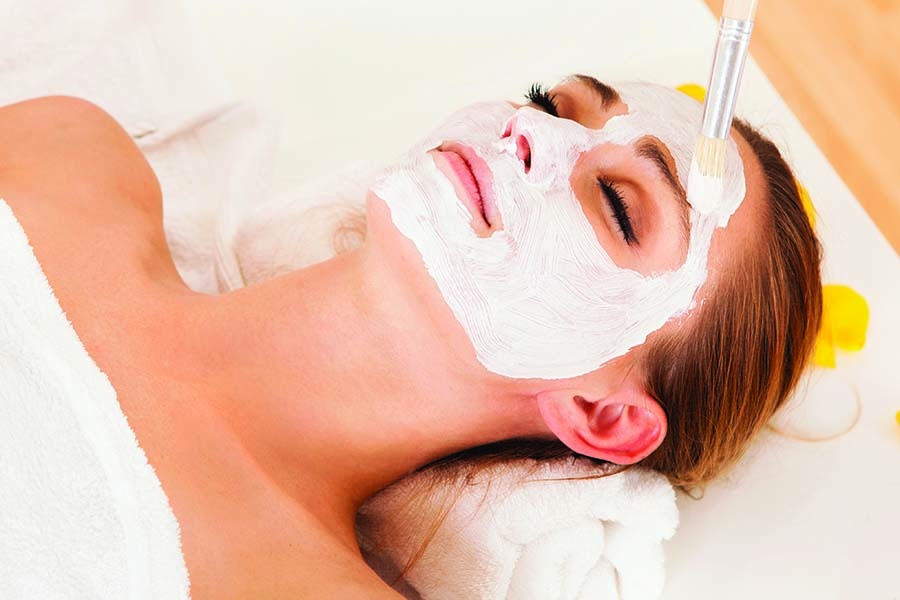Masks: a Mega-Trend
Written by Janel LuuPearls, flowers, honey, snail slime: what do they have in common? Face masks!
Throughout history, men and women have turned to face masks for cosmetic purposes. Ancient Ayurvedic wedding rituals included masks composed of mud, turmeric, roots, and flowers. Cleopatra’s beauty was attributed to masks consisting of donkey’s milk and honey blended with Dead Sea mineral-rich mud. Empresses and concubines in the Tang dynasty brightened their skin using masks made of pearl powder, lotus root, ginger, and egg whites.
Thousands of years later, masks are skyrocketing in popularity, thanks in large part to innovative variations emerging from the world of J- and K-Beauty. Any skin care store, has a myriad choices of beauty masks, many with surprising ingredients that might include snail slime, bee venom, or bird droppings.
RISING STARS OF SKIN CARE
Market research shows that the sheet mask market alone is expected to reach $336 million by 2024 – almost double what it is in 2018. What is more, according to recent search engine reports, face masks are the most googled trend in the skin care market. In fact, DIY face masks are the rising stars in terms of Google searches. A few minutes on YouTube or Instagram will reveal an unending parade of videos demonstrating DIY masks.
Since aestheticians are the official experts on treatments and skin care trends, including masks, why not take advantage of the mask mega-trend to increase the efficacy of treatments, educate clients, and skyrocket bottom line revenue?
MASK MIXOLOGY IN THE TREATMENT ROOM
Be a professional mixologist, creating masking recipes in the treatment room. Take advantage of the flexibility and variety of masks to personalize facial protocols. Enzymes are a great base for building customized treatments. Powder enzymes have the best efficacy when activated with heat, such as steam.
Dehydrated, Mature Skin: Age-Blaster Masking
Mixology 101: Prepare with a microdermabrasion scrub or mandelic acid since its large molecular structure will not damage skin. Mix a powder enzyme mask with oxygenating gel instead of water. This exfoliates and creates an oxygenating blanket that creates an instant glow. Refrigerate the gel ahead of time to provide clients with an extra cooling, refreshing, and soothing sensation after procedures that leave skin irritated.
Mixology 102: Layer a stem cell, growth factor, or hyaluronic serum under a sheet mask, then moisturize and apply eye care and sun protection.
Mixology 103: Blend hyaluronic acid into a gel mask to hydrate and calm dry, irritated, aging skin.
Oily Skin or Acne-Prone Skin: Mineral-Enzyme Masking
Mixology 201: Mix a powder enzyme mask with a mineral-based solution instead of water. Ideal for post-extraction, enzymes help desquamate and detoxify the skin. Adding skin-loving minerals like zinc, magnesium, and potassium relieves inflammation and redness. Plus, minerals assist in clarifying pores and balancing the pH of skin.
Mixology 202: Mix a clay mask with a mineral- or acid-based solution to detoxify the skin. Clay masks can also be blended with exfoliants such as aluminum oxide (in a microdermabrasion scrub) or even sugar.
Sensitive, Dehydrated Skin: Quench-the-Fire Masking
Mixology 301: For sensitive, dehydrated skin, blend a cream mask with hyaluronic acid. Use botanical oils like shea butter, macadamia oil, or rosewood oil to seal in moisture.
Mixology 302: Add cream to an enzyme mask, then use steam to help the mixture seep into the lipid layer of the skin. Azulene is good in soothing masks, since it is distilled from chamomile and has anti-inflammatory benefits that relieve inflamed, irritated skin.
Dull, Hyperpigmented Skin: Get-Your-Glow-On Masking
Mixology 401: After exfoliating, create a vitamin C and E antioxidant cocktail by layering serums with a whitening mask that contains alginate.
Mixology 402: Antioxidant-enriched masks drive oxygen into the skin. This brightens dullness and strengthens the underlying pillars of collagen, plumping fine lines and minimizing other signs of skin aging.
Lines Around the Lips: Lip-Hugging Masking
Mixology 501: Apply a layer of lip cream around and on the lips. Spread thin gauze over the lip area and apply a molding mask for 15 to 20 minutes.
Mixology 502: Lip areas can also be pre-layered with concentrated serums enriched with peptides, ceramides, vitamins, and antioxidants. Hydration and nutrients are propelled into skin, plumping and smoothing lips without moisture evaporating away.
MASKOLOGY FOR CLIENT HOMECARE
After every facial, clients should leave with a couple of masks that suit their skin condition. If they are adventurous, give them a mask prescription for their specific skin care concerns. Include some mixology recipes as their skin care guru and master chef. Inform clients that many sheet masks on the market have low levels of active ingredients, so it is essential to layer concentrated serums underneath sheet masks before applying.
The following are other important guidelines for masking at home, depending on client skin types and conditions.
Normal, Dry, or Dehydrated Skin
Hydrolyzed collagen gel sheet masks reduce flakiness and lock in moisture, while cream sleep masks boost skin cell renewal overnight for firm, plump skin in the morning.
Aging, Photo-Damaged Skin
Growth factor, stem cell, or peptide serum layered underneath a sheet mask boosts collagen and skin renewal, improving the efficacy of cellular communication and repair.
Dullness and Hyperpigmentation
Antioxidant masks, mandelic acid-based masks, and clay masks are ideal for exfoliating, balancing uneven skin tone, and brightening.
Post Microneedling, Dermaplaning, and Peels
Layer a growth factor or peptide serum underneath a sheet or pulp mask to accelerate post-procedure skin recovery.
Combination, Oily Skin
Clay masks, molding masks, acid masks, and oxygen infusion masks remove impurities and excess oil while balancing skin’s water to oil ratio.
Acne-Prone Skin and Clogged Pores
Clay masks absorb excess oil without stripping skin of natural oils essential for maintaining a healthy moisture barrier.
Sensitive and Rosacea-Prone Skin
Sheet masks, gel masks, oxygenating masks, mineral masks, and microsilver masks help reduce redness and inflammation, soothe stressed skin, and promote healing.
DIY DON’TS
If clients want to create their own masks at home, encourage them to be careful about making masks by themselves with ingredients they have purchased. First, there is probably very little attention to quality control when something is mixed up in a kitchen or bathroom. When masks are manufactured in a lab or warehouse, there are strict guidelines to be followed and rigorous requirements for testing for bacteria, mold, and fungus. Also, concocting DIY recipes at home usually does not take into account preservative systems, which could potentially lead to contamination that is then transferred to the skin.
DIY DOS
However, there are ways to DIY safely. For example, a client with acne-prone skin, rosacea, or inflammation can calm skin by steeping a dry sheet mask in a mineral-based solution. Provide the client with the mineral-based solution and sheet mask to combine on an as-needed basis, so there is no risk of mold or contamination by making several masks at once and storing them.
Additionally, here are some tips for clients when masking at home:
- Do not stop at the face. When using sheet masks, instead of immediately discarding the opposite layer, clients should place it on the neck and décolleté so the remaining serum can work its magic.
- Use a handheld ultrasonic tool to drive in sheet mask ingredients.
- Keep sheet masks handy in a purse or office drawer for an instant pick-me-up. Celebrities and models love using these for quick skin recovery and glow.
- Layer growth factor, peptide, or antioxidant-rich serums under eye masks.
- Cream face masks are not just for the face. Clients should use them to moisturize and repair dry, chapped hands, ankles, elbows, and heels.
- When using a peel-off molding mask, place a warm, moist washcloth over the face for 10 to 15 seconds and repeat several times to loosen the mask, making the removal process easier on the skin. Remind clients to never discard pieces of mask down the drain because they will not dissolve and will clog up the drain.
Due to the mask mega-trend, professionals have an even more important role in helping clients improve their skin, express their creativity, and pamper themselves. Homecare masks are a booming business, so provide clients with masks that contain wrinkle-reducing peptides, stable vitamin C, and multiple antioxidants to combat environmental damage and signs of aging. Encourage them to experiment with masks they have not used before. Educate them on how to implement masks as an integral and fun element of their homecare regimen. When clients are taught that professional retail products partnered with masks will even further help their skin to improve, professionals will see retail profits and client satisfaction increase.

-
 Atzen Superior to Organic® Skin Care
Atzen Superior to Organic® Skin Care
Atzen Superior to Organic® Skin Care
Atzen Superior to Organic® Skin Care
-
 DermAware Bio-Targeted Skin Care
DermAware Bio-Targeted Skin Care
DermAware Bio-Targeted Skin Care
DermAware Bio-Targeted Skin Care
-
 GR8/SKN
GR8/SKN
GR8/SKN
GR8/SKN
-
 Rhonda Allison
Rhonda Allison
Rhonda Allison
Rhonda Allison
-
 Shunly Skin Care LCC
Shunly Skin Care LCC
Shunly Skin Care LCC
Shunly Skin Care LCC
-
 Skinprint
Skinprint
Skinprint
Skinprint
https://www.dermascope.com/resources/9477-masks-a-mega-trend?print=1&tmpl=component#sigProId561ffb120f
